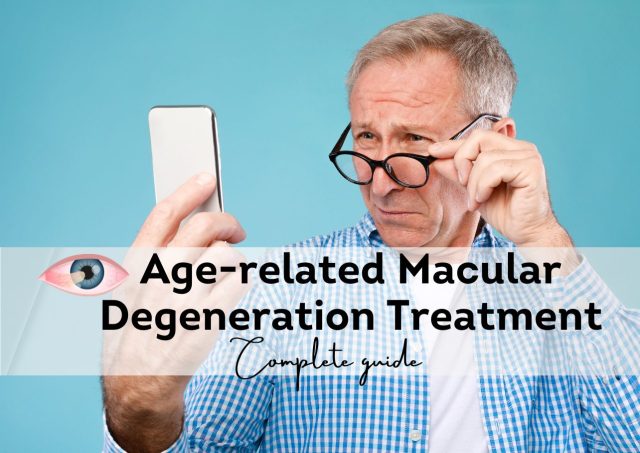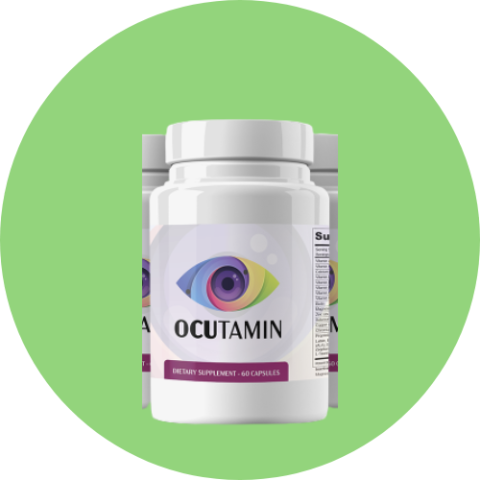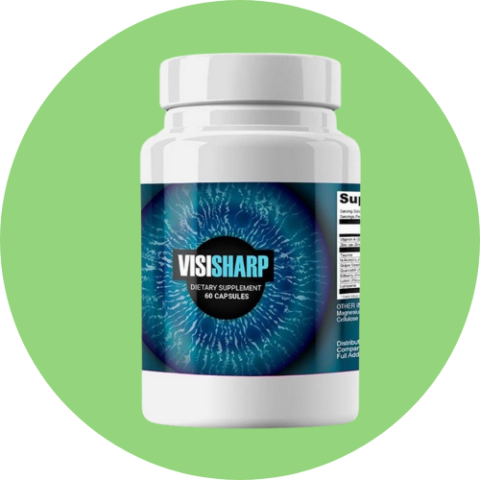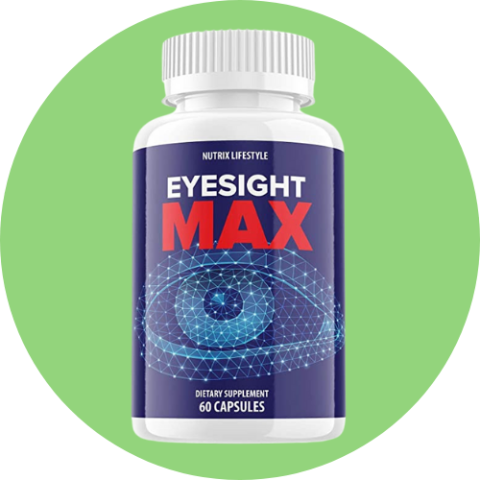Age-Related Macular Degeneration Treatment: Complete Guide 2025
By Vanessa Richards
January 5, 2025 • Fact checked by Dumb Little Man

On average, Americans spend 13 hours a day staring at screens during the pandemic-induced lockdowns.
This increased exposure to digital devices contributed to the rise of vision problems in the country.
Macular degeneration, an age-related eye disease, is now the leading cause of blindness and severe vision loss in the US.
Just like aging, age-related macular degeneration is impossible to stop.
Everyone’s eye health will suffer as we age. So, is age-related macular degeneration treatment a pipedream?
Should people with AMD simply wait until complete blindness takes over their lives?
Absolutely not.
Before AMD causes irreparable vision loss, patients can take many steps to stop or even reverse the damage their eyes experience. Here’s how.
Macular Degeneration Treatment: What is Macular Degeneration?
Age-related macular degeneration (AMD) is a chronic but painless eye condition that affects a person’s central vision. It affects the cells in the middle region of the retina called “macula.”
The macula is the oval-shaped, yellow-colored area surrounding the retina. It’s approximately 5mm in length & breadth but it’s the region of the eye with the keenest vision.
If the group of cells in the middle of the retina, i.e., the macula is damaged, you won’t be able to see fine details clearly. Macular degeneration also affects the retinal pigment called the epithelium.
It’s a special layer of cells found at the base of the retina.
This layer transports sugar, oxygen, & other nutrients to the retina. It also transfers waste products from the retina down to the blood vessels below.
Without the protection of a healthy, fully-functioning retinal pigment epithelium (RPE), our peripheral vision suffers immensely.

In most cases, AMD affects people over the age of 60 years. The risk of developing AMD significantly increases with age.
Although complete vision loss is unlikely, the slow vision loss that patients experience over the years makes their lives extremely difficult. That’s why detecting macular degeneration in its early stages is vital.
Aside from annual eye exams with Optometrists, everyone must learn about the condition.
They must understand what age-related macular degeneration is, its key risk factors, and appropriate prevention strategies.
Here’s a simple guide to start your educational journey.
Decoding Age-Related Macular Degeneration
There are two types of age-related macular degeneration: wet & dry. Both lead to severe vision problems.
Dry AMD
In dry macular degeneration (also known as atrophic AMD), the macula (the center region of the retina) deteriorates. This deterioration is gradual & it happens naturally as people age.
There’s no permanent cure. But, there are strategies that patients can learn to prevent or cope with this eye disease.
This dry form of AMD accounts for over 85% of all cases involving age-related macular degeneration.
Wet AMD
In wet macular degeneration (also known as exudative AMD), new blood vessels form under the patient’s macula. These abnormal blood vessels cause blood and other fluids to leak from the eyes.
The leaking blood vessels can only be stopped if a doctor injects the right drugs into the patient’s eyes. Typically, wet AMD progresses very quickly (much faster than dry macular degeneration).
Approximately 15% of people with dry AMD go on to get the wet form of this condition.

8.7% of all cases of blindness in the world are caused by dry & wet macular degeneration. There’s another form of macular degeneration that only affects younger people.
It’s called “Juvenile macular degeneration” and it’s caused purely due to genetic factors.
But, most of these conditions are not caused by genetic factors alone.
There are three stages of AMD – early AMD, intermediate AMD, and late AMD. The early stages of dry macular degeneration are typically hard to spot as patients don’t experience many symptoms.
In wet AMD, new blood vessels form under the eye constantly so visiting a professional Optometrist is a must.
What Causes Macular Degeneration?

Dry AMD
Most people with central vision issues have dry macular degeneration. This condition is caused when tiny bits of protein & fat (called drusen) collect under the retina.
These tiny yellow deposits are waste items from the retina that aren’t discarded properly. They block the retina instead.
All people over the age of 50 have these tiny yellow deposits in their eyes.
As long as drusen doesn’t block the light sensitive cells in your macula, they’re normal and harmless. But, when they block the macula at the center of your retina, you experience vision problems.
This layer of tissue is responsible for processing light.
When drusen blocks it, your vision suffers. The longer you experience dry AMD, the bigger the drusen get in size.
Your condition then moves from early stage AMD to intermediate AMD & then finally to advanced-stage AMD. In this final stage, the drusen are larger in size and numbers.
They prevent oxygen from reaching the blood vessels in your eye.
Wet AMD
It is caused by the formation of new, leaky & abnormal blood vessels underneath the macula. These leaking blood vessels leak fluids (blood & water) into your eye, causing extensive damage.
Why do new blood vessels form in the eyes of patients with wet macular degeneration? It's unclear why these abnormal blood vessels form.
Some eye doctors think it’s the eye’s natural response to all the drusen accumulating near the retina. If you have dry AMD in one eye or both eyes, you won’t experience serious vision-related problems.
But, your problems will increase in intensity gradually with time as you age. Dry macular degeneration can take on the wet form as well.
Macular Degeneration: The Main Risk Factors
Not all causes of AMD are preventable. For instance, scientists have identified 20+ genes that are linked to AMD.
So, if your parents pass down this condition to you, you can’t do anything about it. But, genes, medical, and family history aren’t the only causes of AMD.
There are other things that raise a person’s chances of getting macular degeneration. They include:
Age
The more your eyes age, the likelier you are to get age-related macular degeneration.
Ethnicity
Caucasian people have a much higher risk of getting AMD than African Americans.
Sex
Since women generally live longer than men, they’re at a higher risk of developing AMD.
Smoking
Smokers have a four times higher risk of getting AMD compared to non-smokers.
High Blood Pressure
The eyes of people with high blood pressure don’t get as much oxygen as they need. This deficiency causes eye pressure and raises their risk for AMD.
Medications
Some medications may be linked with AMD. For instance, taking oral beta-blockers increases the risk of getting wet AMD by 71%.
The same goes for beta-carotene, a medication used for treating heart diseases.
Diet
High-fat, high-sugar, and low-protein diets add to the risk of getting AMD.
Alcohol
Having more than two alcoholic drinks per day also increases the risk of getting dry AMD.
Surgery
The chances of getting AMD increase when people undergo laser surgery, cataract surgery, and other eye operations.
If you only have AMD in one eye, the chances of you developing it in the other eye are extremely high. Before that happens, you can spot the symptoms of this progressive disease & stop it from causing you further vision loss.
Age-Related Macular Degeneration: The Most Glaring Symptoms
Here are the key symptoms of macular degeneration that get progressively worse with time.
- Reductions in central vision
- Straight lines in your field of vision appearing distorted (straight lines of light appearing curved in your eyes)
- The need to install brighter lights in your room
- Difficulty seeing anything in low lights
- Trouble recognizing faces from a distance due to blurriness
- These symptoms are experienced by patients of both wet and dry AMD. People with wet macular degeneration also experience –
- Hazy visions & hallucinations (similar to those experienced by people with Charles Bonnet syndrome)
- A dark, blurry spot in the center of your field of vision due to bleeding and leaking blood vessels
- Swiftly worsening symptoms
According to the National Eye Institute (NEI), advanced wet macular degeneration progresses extremely quickly. To slow it down, patients must visit eye doctors as quickly as possible.
>> Related Article: How to Reduce Eyestrain Symptoms: Complete Guide 2025
Diagnosing Macular Degeneration
There are many diagnostic tools & eye exams that eye doctors use to diagnose this condition. They include:
- Amsler grid tests
- Fluorescein angiography
- Indocyanine green angiography
- Optical coherence tomography (OCT)
Treatment for Macular Degeneration
Natural Remedies
If you receive a diagnosis of dry AMD, you can try the following natural remedies to prevent further vision loss:
- Avoid beta carotene
- Eat more leafy greens vegetables (kale, spinach, broccoli, etc.)
- Reduce sugar intake
- Consume food items rich in omega-3 fatty acids like fish
- Eat more high-fiber fruit.
- Get regular exercise & maintain a healthy weight
- Maintain healthy blood pressure and cholesterol levels to keep your eye pressure levels in check
- Quit smoking
- Manage your existing medical conditions
- Taking mineral & vitamin supplements (especially Vitamin E supplements)
- Have routine eye exams
People with wet macular degeneration will also benefit from taking these steps. But, these patients must also do close-up work with low-vision rehabilitation specialists.
Eligible patients have to meet very strict criteria to qualify for complicated procedures like optical coherence tomography or photodynamic therapy.
These solutions are only meant for patients who’ve experienced severe vision problems.
So, dry AMD patients typically don’t opt for such solutions.
Instead, they’re advised to use low vision aids and natural solutions to prevent their conditions from getting worse.
There are many all-natural nutritional supplements that such patients can take to prevent rapid macular degeneration.
Supplements
3 Best All-Natural Nutritional Supplements for Macular Degeneration
| Product | Key Feature |
|---|---|
| Top Consumer's Choice | |
| Best Supplement To Reduce Inflammation | |
| Best Supplement To Eliminate Eye Toxins |
1. Top Consumer's Choice: Ocutamin
Almost every eye doctor recommends this eye vitamin supplement to patients because of its effectiveness. Ocutamin improves the sharpness of the eyes.
By doing so, it minimizes the negative effects of age-related macular degeneration. You can be an old person and still have clear vision if you use this eye vitamin supplement.
Ocutamin consists of:
- Bilberry
- Lutein
- Quercetin
- Zeaxanthin
These ingredients combine to remove all the toxin buildup in the eyes. No toxins mean less risk of eye strains and blindness.
Shop at Ocutamin Official Website
2. Best Supplement To Reduce Inflammation: Visisharp
Visisharp capsules are designed to treat various diseases that damage your ocular system. Even patients with the Charles Bonnet syndrome use this nutritional supplement.
Consuming just two capsules of Visisharp a day will prevent inflammations and eye infections from damaging your ocular system. It will also kickstart a self-repair process for your eyes & body.
The ingredients in Visisharp will improve your gut health. Gut health indirectly impacts your eye health so consuming these ingredients will always be beneficial.
The ingredients are:
- Grape Seeds
- Vitamin A
- Taurine
- Zinc
- Marigold Flower
- Quercetin
- Bilberry Extracts
By ingesting the capsules, you’ll be giving your body the valuable nutrients it needs to nourish damaged eyes. People who take Visisharp for long periods also have better blood & stomach health.
Every age-related eye disease study on this nutritional supplement has confirmed these benefits. No side effects of Vishisharp have been reported so far.
Shop at Visisharp Official Website
Full Article: Visisharp Reviews : Does it Really Work?
3. Best Supplement To Eliminate Eye Toxins: Eyesight Max
Packed with great ingredients like Lutein & Zeaxanthin, Eyesight Max is one of the most potent antioxidant supplements out there.
These powerful antioxidants prevent toxin buildup in different parts of the body – from your ocular system to your lungs.
They’re the same antioxidants doctors use to treat lung cancer.
Eyesight Max contains powerful antioxidative ingredients like:
- Bilberry
- Omega 3 Fatty Acids (Fish Oil)
- Lutein
- Quercetin
- Zeaxanthin
Eyesight Max prevents macular degeneration by preventing environmental toxins like PM2.5 from damaging your body.
Without antioxidative treatment, these toxins would stay inside & damage your body forever.
Eyesight Max can also make people feel more energized and prevent headaches and migraines caused by sleeplessness.
Shop at Eyesight Max Official Website
Full Article: Eyesight Max Reviews: Does it Really Work?
Conclusion
Macular degeneration is technically “incurable” but that doesn’t mean its stoppable or preventable. Timely eye exams and consuming the right supplements can greatly reduce your risk of picking up serious vision problems.
Ocutamin, in particular, is an FDA-approved supplement that anyone with vision problems can benefit from. Just like Ocutamin, all the supplements mentioned in this list are “all-natural” and safe for consumption.
But Ocutamin has proven itself to be the leading supplement when it comes to age-related macular degeneration.
Use this guide to regulate your lifestyle and fight macular degeneration head-on!
Click here to get Ocutamin at a Discounted Price
>> Related Article: 5 Best Eye Vitamins and Supplements in 2025 • All Natural Supplements
Macular Degeneration Treatment FAQs
What is the best treatment for macular degeneration?
Laser therapy, fluorescein angiography, and photodynamic therapy are some of the latest & most effective treatments for macular degeneration.
Can macular degeneration be stopped from progressing?
Yes. Regular eye exams, maintaining a healthy diet, and listening to your eye doctor’s advice can help prevent dry AMD from progressing.
How long does it take to go blind with macular degeneration?
Dry AMD can take up to 10 years to evolve into complete blindness. Serious cases of wet AMD often evolve into full or partial blindness in less than 3 months.
Can macular degeneration be healed?
No. But, it can be prevented & slowed down.
Vanessa Richards
Vanessa is a mom of 3 lovely children and a software geek. Outside of her career as a health and wellness instructor. She enjoys writing and researching on topics such as finance, software, health and culinary.




